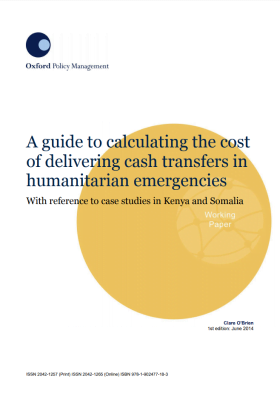A Guide to Calculating the Cost of Delivering Cash Transfers in Humanitarian Emergencies – With reference to case studies in Kenya and Somalia
The emergence of cash transfers as a viable alternative to in-kind aid – such as food or shelter materials – for households affected by humanitarian disasters has been documented for some years now. Under certain conditions, when local markets are able to accommodate increased demand and prices will remain stable, cash hand-outs may offer benefits to recipients and donors alike. Households have the flexibility to meet their own needs as they choose, often with great freedom as to what they can buy, and where and when they buy it. Meanwhile, humanitarian agencies may experience a lighter logistical burden as cash transfers do not require the procurement, transportation and storage of in-kind goods. One consideration among several when determining whether a cash transfer is an appropriate humanitarian response is the cost of the programme. This is important in the context of policy debates on ‘value for money’, since what matters is not just the effectiveness of the programme but how much it has cost to run it, and whether that money might have been better spent on an alternative intervention. This working paper presents a method for determining retrospectively the cost of a cash transfer programme and for understanding the implications of the cost for the design, implementation and possible scale-up of the intervention. The target audience for this paper are those responsible for the funding, design, implementation and analysis of cash transfer programmes in humanitarian contexts. However, the method described is also applicable to the analysis of the cost of longer term social assistance programmes, not just those in an emergency setting. We hope that, by using this step-by-step guide to analysing cash transfer programme costs, agencies can contribute to a body of evidence on cost, built around a common analytical framework. This may facilitate the comparison of interventions across and within countries, and promote an understanding of the factors that influence the cost-efficiency of cash transfers.



